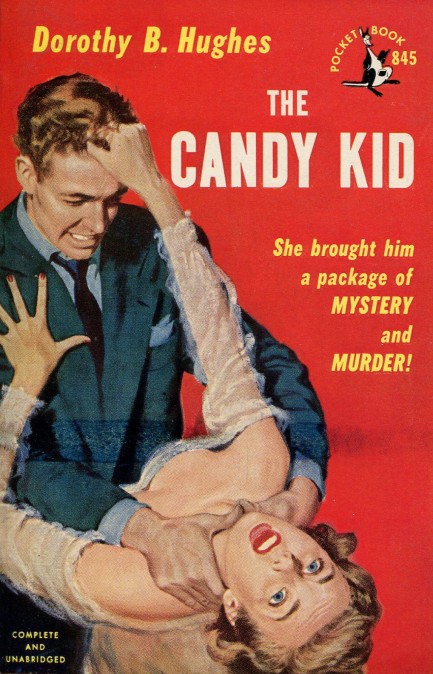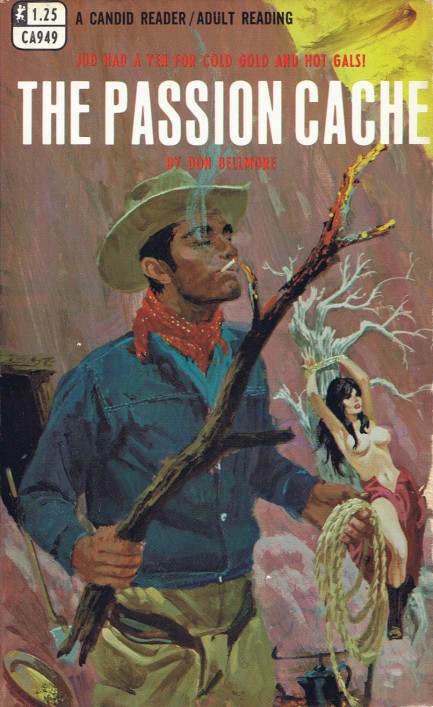 You knew those Reese's Cups were mine but you ate them anyway! Was it worth it? Well? Was it worth it? 
This is a rarity on mid-century paperbacks—the strangler on Edward Vebell's cover for the 1951 thriller The Candy Kid is the protagonist. We almost never see one like this where the aggressive male isn't the villain, but it happens. In this case, he thinks the femme fatale has murdered his cousin. But he gets ahold of himself after a few seconds and gives her a chance to convince him that he's wrong. Telling you that isn't a spoiler, because the rear cover text reveals the murder anyway, and the hero's reaction isn't a turning point within the plot. He's pissed. But he gets over it.
The Candy Kid was written by the respected Dorothy B. Hughes, and she sticks close to the American southwest she explored in books such as 1946's Ride the Pink Horse. Here her main character, José “the Strangler” Aragon, is randomly selected on the streets of El Paso by upper class beauty Dulcinda “Sore Neck” Farrar to do a shady favor—take an envelope to across the border to Ciudad Juarez and exchange it for a package to be returned to her. She's chosen him because he looks like an itinerant laborer, like someone who needs, “un poco dinero.”
Actually, though, Aragon is a well-to-do rancher. He'd just gotten back from cowpunching when Dulcinda saw him, and he was sweaty and covered in grime. The whole thing was a joke to him. Based on her assumption, he'd pretended to be an immigrant day laborer, planning to reveal himself as a man of means to the pretty gringa later. But he takes more and more interest in this package business, and ends up performing the errand. Then the package is stolen from him.
What follows is a mystery involving a Greek crime kingpin, murder and revenge, twists and surprises, and unsolved crimes across the border. The odd title of the book comes from Dulcinda's name. Everyone calls her Dulcy, which in Spanish sounds like “dulce,” which means “sweet,” which causes one of the Mexican characters trying to remember her name to say, “that candy kid.” It's an involved journey. But then so is the tale.
We'll just come out and say it isn't Hughes' best, but she's always a fascinating author, particularly here, where she deftly captures the border atmosphere and attempts to portray a Mexican-American character who speaks Spanish and is comfortable on either side of the Rio Grande, yet is culturally distinct from his cousins down south. Some of those interactions have subtle class tensions that make them among the most interesting in the book. Other areas of the story are less successful. The biggest flaw is character motivation—Aragon has no compelling reason to get involved in Dulcy's troubles until his cousin dies, at the halfway mark. Following through on a prank just isn't enough. But you can't fault the level of technical skill on display, although Hughes writes in an unusual style filled with comma splices: It would have been funny, he was always the one who delayed the crowd, he knew everyone from Chihuahua to Mesa Verde. It works fine, which proves that if done just right an author can break any rule they want. Well, almost any rule. A crucial one for genre fiction is: make sure your protagonist really wants something. Even Hughes wasn't able to break that one and get away with it.
 Yup. Done gave myself more’n a few painful burns over the years with this trick but I got it down pretty good now. 
The cover art by Robert Bonfils makes The Passion Cache look like a western but it’s actually set in the present day, or at least 1968, which is when Don Bellmore, aka George H. White, wrote the book. It deals with two fraternity buddies who go looking for twenty-thousand dollars worth of Spanish gold in the mountains above El Paso, Texas. But this is sleaze fiction, not adventure fiction, so the quest for gold is really secondary to the main character Jud’s quest to do some prospecting between the thighs of his friend’s wife Viola, an Indian girl named Desert Rose, and an eager virgin/tomboy named Sally. He’s successful on all counts, multiple times. Does he eventually end up with the gold? No, but he ends up with Desert Rose, and that’s pretty much what these books are all about.
|
 |

The headlines that mattered yesteryear.
1933—The Gestapo Is Formed
The Geheime Staatspolizei, aka Gestapo, the official secret police force of Nazi Germany, is established. It begins under the administration of SS leader Heinrich Himmler in his position as Chief of German Police, but by 1939 is administered by the Reichssicherheitshauptamt, or Reich Main Security Office, and is a feared entity in every corner of Germany and beyond. 1937—Guernica Is Bombed
In Spain during the Spanish Civil War, the Basque town of Guernica is bombed by the German Luftwaffe, resulting in widespread destruction and casualties. The Basque government reports 1,654 people killed, while later research suggests far fewer deaths, but regardless, Guernica is viewed as an example of terror bombing and other countries learn that Nazi Germany is committed to that tactic. The bombing also becomes inspiration for Pablo Picasso, resulting in a protest painting that is not only his most famous work, but one the most important pieces of art ever produced. 1939—Batman Debuts
In Detective Comics #27, DC Comics publishes its second major superhero, Batman, who becomes one of the most popular comic book characters of all time, and then a popular camp television series starring Adam West, and lastly a multi-million dollar movie franchise starring Michael Keaton, then George Clooney, and finally Christian Bale. 1953—Crick and Watson Publish DNA Results
British scientists James D Watson and Francis Crick publish an article detailing their discovery of the existence and structure of deoxyribonucleic acid, or DNA, in Nature magazine. Their findings answer one of the oldest and most fundamental questions of biology, that of how living things reproduce themselves. 1967—First Space Program Casualty Occurs
Soviet cosmonaut Vladimir Komarov dies in Soyuz 1 when, during re-entry into Earth's atmosphere after more than ten successful orbits, the capsule's main parachute fails to deploy properly, and the backup chute becomes entangled in the first. The capsule's descent is slowed, but it still hits the ground at about 90 mph, at which point it bursts into flames. Komarov is the first human to die during a space mission.
|

|
|

It's easy. We have an uploader that makes it a snap. Use it to submit your art, text, header, and subhead. Your post can be funny, serious, or anything in between, as long as it's vintage pulp. You'll get a byline and experience the fleeting pride of free authorship. We'll edit your post for typos, but the rest is up to you. Click here to give us your best shot.

|
|








































































